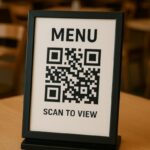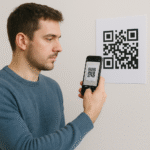
Top QR Code Uses in world in 2025: Government, Retail & Social Impact
Posted in :
Introduction: QR Codes Beyond the Basics
While most people associate QR codes with restaurant menus and marketing campaigns, 2025 has witnessed an extraordinary expansion of QR technology into critical sectors that shape our daily lives. From government digital identity systems to life-saving humanitarian applications, QR codes have evolved into essential infrastructure for the modern world.
This comprehensive analysis explores the most impactful QR code implementations across three transformative sectors: government services, retail innovation, and social impact initiatives that are literally changing lives across the globe.
Government Sector: Digital Governance Revolution
Digital Identity and Citizenship Services
Estonia’s E-Residency Program Estonia continues leading digital governance with QR-enabled digital identity cards that provide instant access to over 4,000 government services. Citizens scan QR codes to access tax filing, business registration, and healthcare records—all through secure, blockchain-verified transactions.
India’s Aadhaar Integration With over 1.3 billion registered users, India’s Aadhaar system uses QR codes for instant identity verification across banking, telecommunications, and government benefit distribution. The system processes over 2 billion authentications monthly, making it the world’s largest QR-based identity platform.
Singapore’s SingPass Digital ID Singapore’s national digital identity system enables citizens to access 1,400+ government services through QR code authentication, from passport renewals to business license applications, all completed in minutes rather than days.
Public Transportation and Urban Mobility
China’s Transportation Revolution Over 300 Chinese cities now use unified QR payment systems for public transport. Beijing’s subway system alone processes 40 million QR code transactions weekly, while cities like Shenzhen have achieved 95% mobile payment adoption across all transportation modes.
European Smart City Integration Cities like Amsterdam, Barcelona, and Vienna use QR codes for integrated mobility services—one scan provides access to buses, bike-sharing, parking, and even tourist information, creating seamless urban experiences for 50+ million annual users.
Healthcare and Emergency Services
South Korea’s Digital Health Passport Post-pandemic, South Korea maintains QR-based health verification systems that instantly verify vaccination status, recent test results, and health insurance eligibility across healthcare facilities nationwide.
Emergency Response Systems Countries including Japan, New Zealand, and Switzerland use QR codes on public infrastructure for emergency information access, providing instant multilingual safety instructions and emergency contact systems.
Retail Sector: Commerce Transformation
Omnichannel Shopping Experiences
Amazon’s Physical Store Integration Amazon Go and Amazon Fresh stores use QR codes for seamless checkout-free shopping experiences across 50+ locations. Customers scan once to enter, shop freely, and receive automatic billing—processing over 1 million transactions monthly.
Walmart’s Supply Chain Transparency Walmart’s global supply chain uses QR codes to provide complete product traceability. Customers can scan codes to see farm-to-shelf journeys, supporting the company’s $2 billion investment in supply chain transparency.
Uniqlo’s Smart Retail Innovation Japanese retailer Uniqlo uses QR codes for size recommendations, styling suggestions, and inventory checking across 2,000+ global stores, processing over 10 million scans monthly and increasing customer satisfaction by 35%.
Payment and Financial Services
Africa’s Mobile Money Revolution Kenya’s M-Pesa system processes over $1 billion monthly through QR code payments, while similar systems in Ghana, Tanzania, and Uganda serve 50+ million users, providing banking services to previously unbanked populations.
Brazil’s PIX Payment System Brazil’s instant payment system processes 3+ billion QR code transactions annually, making it Latin America’s fastest-growing payment method and reducing cash transactions by 40% in urban areas.
India’s UPI Ecosystem India’s Unified Payments Interface handles 8+ billion QR code transactions monthly, worth over $200 billion annually, making it the world’s largest real-time payment system by volume.
Inventory and Logistics
Zara’s Fast Fashion Optimization Zara uses QR codes throughout their supply chain for inventory tracking, enabling their famous 2-week design-to-store cycle across 2,000+ global locations.
DHL’s Smart Logistics DHL’s global network uses QR codes for package tracking and warehouse automation, processing 1.8 billion packages annually with 99.7% accuracy rates through QR-enabled systems.
Social Impact: Technology for Good
Education and Digital Literacy
UNESCO’s Learning Passport Initiative The Learning Passport uses QR codes to provide educational content access for refugee children across 15 countries, serving 2+ million displaced students with personalized learning materials in 40+ languages.
India’s Digital Education Revolution India’s DIKSHA platform delivers educational content through QR codes to 50+ million students, with teachers scanning codes to access lesson plans, assessments, and multimedia resources aligned with national curricula.
Rwanda’s Digital Classroom Project Rwanda uses QR codes in textbooks to link to supplementary digital content, serving 3+ million students and achieving 95% primary school enrollment through technology-enhanced education.
Healthcare Access and Medical Information
Doctors Without Borders (MSF) Field Operations MSF uses QR codes for patient record management in crisis zones, enabling instant access to medical histories and treatment protocols across 70+ countries, treating 13+ million patients annually.
WHO’s Vaccination Verification The World Health Organization’s digital vaccination certificates use QR codes for global health verification, supporting international travel and health monitoring across 100+ participating countries.
Telemedicine in Rural Areas Organizations like Partners in Health use QR codes to connect rural patients with specialist doctors via telemedicine platforms, serving remote communities across Haiti, Rwanda, and Peru.
Humanitarian Aid and Disaster Response
World Food Programme’s Digital Food Assistance WFP uses QR codes for food distribution in refugee camps, serving 100+ million people annually across 80+ countries with transparent, efficient aid delivery systems.
Red Cross Emergency Response The International Red Cross uses QR codes for disaster response coordination, enabling instant access to emergency supplies, volunteer coordination, and family reunion services across global operations.
UNHCR Refugee Services The UN Refugee Agency uses QR codes for identity verification and service access in refugee camps worldwide, serving 35+ million displaced persons with essential services and protection.
Environmental Conservation
WWF’s Wildlife Protection WWF uses QR codes on products to verify sustainable sourcing and support conservation projects, raising over $50 million annually for environmental protection through consumer engagement.
Ocean Cleanup Verification The Ocean Cleanup project uses QR codes to track plastic waste collection and recycling, providing transparency for 100+ million pieces of ocean plastic removed and processed.
Emerging Global Trends and Innovations
Artificial Intelligence Integration
Smart City AI Systems Cities like Dubai and Singapore integrate QR codes with AI systems for predictive urban planning, traffic optimization, and resource allocation, serving 15+ million residents with intelligent city services.
Personalized Experience Platforms Retail chains and service providers use AI-powered QR systems to deliver personalized experiences based on scan history and preferences, increasing customer engagement by 60%.
Blockchain and Security Applications
Supply Chain Verification Companies like Walmart, Nestlé, and Unilever use blockchain-secured QR codes for product authenticity verification, protecting consumers from counterfeit goods across global markets.
Digital Rights Management Artists and content creators use blockchain-secured QR codes for intellectual property protection and royalty distribution, creating new revenue models for creative industries.
Internet of Things (IoT) Connectivity
Smart Infrastructure Smart cities use QR codes as triggers for IoT device interactions, from smart parking systems to environmental monitoring stations, creating responsive urban environments.
Connected Product Ecosystems Manufacturers embed QR codes in products to connect them to IoT networks, enabling predictive maintenance, usage analytics, and enhanced customer service.
Implementation Success Factors
Government Adoption Strategies
Citizen-Centric Design Successful government QR implementations prioritize user experience, providing clear instructions, multilingual support, and accessible design for all demographic groups.
Security and Privacy Leading implementations incorporate robust security measures, data encryption, and transparent privacy policies to build citizen trust and ensure sustainable adoption.
Retail Innovation Drivers
Seamless Integration Successful retail QR implementations integrate smoothly with existing systems, providing additional value without disrupting established customer behaviors.
Measurable Value Creation Top-performing retail QR initiatives demonstrate clear ROI through increased sales, improved customer satisfaction, or operational efficiency gains.
Social Impact Measurement
Outcome-Focused Metrics Effective social impact QR programs measure real-world outcomes—lives improved, services accessed, or problems solved—rather than just scan volumes or technical metrics.
Community Engagement Sustainable social impact initiatives involve local communities in design and implementation, ensuring cultural appropriateness and long-term viability.
Creating Your Own QR Impact
For Organizations and Businesses
Whether you’re implementing government services, retail innovations, or social impact initiatives, the key to QR success lies in understanding user needs and delivering genuine value through technology.
Start Simple, Scale Smart Begin with clear, specific use cases that solve real problems for your audience. Build expertise and user trust before expanding to more complex applications.
Measure What Matters Track meaningful metrics that align with your organizational goals—whether that’s citizen satisfaction, sales conversion, or social impact outcomes.
Tools for Implementation
For organizations ready to join the global QR revolution, QRCodeMyURL.com provides the reliable, professional-grade QR generation needed for serious applications:
- Enterprise-Ready: No limitations on scan volume or usage
- Security-Conscious: No data collection or tracking
- Globally Accessible: Works worldwide without regional restrictions
- Multi-Format Support: URLs, Wi-Fi, vCards, and specialized formats
Create Professional QR Codes for Your Initiative →
Future Outlook: QR Codes in 2026 and Beyond
Technological Evolution
5G and Enhanced Connectivity Ultra-fast 5G networks will enable more sophisticated QR applications, from real-time augmented reality experiences to instant high-definition content delivery.
Advanced Authentication Biometric integration and advanced encryption will make QR codes even more secure, supporting high-stakes applications in finance, healthcare, and government services.
Global Expansion
Developing Market Growth Countries across Africa, Latin America, and Southeast Asia are rapidly adopting QR technology for financial inclusion, government services, and educational access.
Cross-Border Integration International standards for QR applications will enable seamless cross-border experiences for travel, trade, and global service delivery.
Conclusion: The QR-Enabled Future is Now
The examples highlighted in this analysis represent just the beginning of QR technology’s global impact. From enabling digital governance in Estonia to feeding refugees through WFP programs, QR codes have transcended their origins as simple marketing tools to become essential infrastructure for the modern world.
The success stories across government, retail, and social impact sectors demonstrate that QR codes are not just convenient—they’re transformative. They’re breaking down barriers to access, creating new possibilities for human connection, and solving complex problems with elegant simplicity.
As we look toward the future, the question isn’t whether QR codes will continue growing in importance—it’s how quickly organizations can adapt to leverage this powerful technology for positive impact.
Ready to be part of the global QR revolution? Start creating professional QR codes today with QRCodeMyURL.com—no signup required, unlimited potential.
Related Deep Dives
- Government Digital Transformation Guide – Implementing QR systems in public services
- Retail QR Code ROI Calculator – Measuring success in commercial applications
- Social Impact QR Case Studies – Detailed analysis of humanitarian applications
- QR Security Best Practices – Protecting sensitive applications and data
Sources and Data: This analysis is based on publicly available reports from government agencies, NGOs, and international organizations. Statistics reflect the most recent available data as of 2025.

